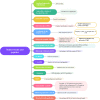Gut microbiome: decision-makers in the microenvironment of colorectal cancer
- PMID: 38156313
- PMCID: PMC10754537
- DOI: 10.3389/fcimb.2023.1299977
Gut microbiome: decision-makers in the microenvironment of colorectal cancer
Abstract
Colorectal cancer (CRC) is a common malignancy of the gastrointestinal tract, accounting for the second most common cause of gastrointestinal tumors. As one of the intestinal barriers, gut bacteria form biofilm, participate in intestinal work, and form the living environment of intestinal cells. Metagenomic next-generation sequencing (mNGS) of the gut bacteria in a large number of CRC patients has been established, enabling specific microbial signatures to be associated with colorectal adenomato-carcinoma. Gut bacteria are involved in both benign precursor lesions (polyps), in situ growth and metastasis of CRC. Therefore, the term tumorigenic bacteria was proposed in 2018, such as Escherichia coli, Fusobacterium nucleatum, enterotoxigenic Bacteroides fragilis, etc. Meanwhile, bacteria toxins (such as cytolethal distending toxin (CDT), Colibactin (Clb), B. fragilis toxin) affect the tumor microenvironment and promote cancer occurrence and tumor immune escape. It is important to note that there are differences in the bacteria of different types of CRC. In this paper, the role of tumorigenic bacteria in the polyp-cancer transformation and the effects of their secreted toxins on the tumor microenvironment will be discussed, thereby further exploring new ideas for the prevention and treatment of CRC.
Keywords: colorectal cancer; gut bacteria; immune escape; therapy; tumor microbial microenvironment.
Copyright © 2023 Han, Zhang, Zhang, Yin, Cui, Liu, Yang, Song and Shang.
Conflict of interest statement
The authors declare that the research was conducted in the absence of any commercial or financial relationships that could be construed as a potential conflict of interest.
Figures
References
Publication types
MeSH terms
LinkOut - more resources
Full Text Sources
Medical
Research Materials




